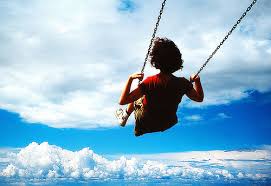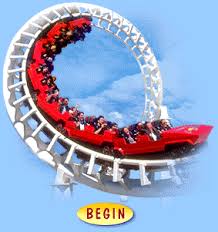Since the Earth's ace second, have something in this world stimulated our semicircular canals. I have always been thinking that why the stimulation of the semicircular fluid at times stimulates the hormone of delighfulness? In simple words what I mean is that, the semicircular fluid senses motion and the merriment hormone controls feelings. So I always wonder why certain motions amaze us and certain cause uneasiness?
 As a human we just love certain kinds of motion. Some motions catch our attention and the others impart joy to us. Each one of us would have enjoyed at least once the ride of a swing. How pleasury it feels when we gush through the air, in quick movements. We feel the peak of emotions and its the most joyous of feelings. When we jump up high, even then we feel glad.
As a human we just love certain kinds of motion. Some motions catch our attention and the others impart joy to us. Each one of us would have enjoyed at least once the ride of a swing. How pleasury it feels when we gush through the air, in quick movements. We feel the peak of emotions and its the most joyous of feelings. When we jump up high, even then we feel glad.
So in the aforesaid cases, the motion amazed us. We can call such a motion that amazes us: amazing + move = amazove.
Certain other amazoves include the movement of a speeding car. This proves that the faster the motion, the more is its fun, just in case of amazoves. If the car is just very slow, it wouldn't have been much amazing as this. So we can say that: amazement ∝ amazove.
Sometimes there are some motions that causes uneasiness. The motion that is a continuous round, or a ride of a roller coaster, or a car moving on a hill, or when you move round and round on your feet or shake your head or rotate your eyes. Such motions are really heralding and can even be accompanied by nausea.
 Such kind of motions are called dizziness + move = dissove. In this case too, the faster is the motion, the more is the dizziness. In other words: dizziness ∝ dizzove.
Such kind of motions are called dizziness + move = dissove. In this case too, the faster is the motion, the more is the dizziness. In other words: dizziness ∝ dizzove.
But something that is wrangling in the study of motions, is that each human does not experience the same feeling. So an amazove for a person can be a dizzove for the other one. Even the intensity of amazement and dizziness differs from person to person. So it depends on the person's semicircular canal fluid's stability and the secretion of the merriment hormone.
Sometimes motions are not to be felt, but just to be seen. At occasions, it happens that the motion attracts perception. It happens in case of babies for the most. If a baby's crying, and if he notices some moving toy, then his cornea would be attracted to it and the baby's thinking would be occupied over it. Not only babies, even grown ups love motion. One would prefer watching a movie, rather than gazing at still photographs. That is why the concept of cinemas was developed. The cinematographers in early ages used to earn money taking advantage of the perceptive attraction to motion.
Certain perceptive motions are not delighting. If a dancer dances well, then the motion delights us. But if the dancer dances rigidly and without any attractive motion, then the attentive perception shall be less, leading to a loss of delightment. Certain perceptive motions may make us giggle and certain, if continuously stared at, may make us feel sleep and cozy.
In case of science projects too, every person would peep into the working models. Though the stationary projects and models might be better, but the motion would attract audience. Even the judges give more preference to motion.
Flowing water is always much to look at then the dirty stagnant water. Blowing wind always makes us feel jolly.
So the perceptive attractive motion are called perco-amazoves. If the intensity of the perco- amazoves is increased, then: perco- amazove + perco- amazove = dizzove. Because then it will force the eyeballs to move faster and would lead to the uneasiness- filled movement. Even in this case the result differs from person to person.
So we in our life, are to much bonded with motion. The adhesive bonding is not always perfect. Sometimes it might spread delight, but the other times it can cause problems too. There aren't just the above discussed motions, but there are hundreds of other kinds of motion.
The most favorite and astonishing motion I have ever experienced is the motion of the Earth. We do feel it, but we have no effect of it on our body directly. But to a greater extent the rotation and revolution are necessary for our survival.
So we are completely attached to motion, it is how just the motion of a small toy can attract a child's attention. Though we have given to much attention to motion till now, but never thought of what delighted us.
Yes, this is my question. What is in motion, that can stimulate our happiness and uneasiness? Is it that there's some connection with the happiness secretion and the semicircular canal movement? Or is it just a mystery, never to be revealed???
So in the aforesaid cases, the motion amazed us. We can call such a motion that amazes us: amazing + move = amazove.
Certain other amazoves include the movement of a speeding car. This proves that the faster the motion, the more is its fun, just in case of amazoves. If the car is just very slow, it wouldn't have been much amazing as this. So we can say that: amazement ∝ amazove.
Sometimes there are some motions that causes uneasiness. The motion that is a continuous round, or a ride of a roller coaster, or a car moving on a hill, or when you move round and round on your feet or shake your head or rotate your eyes. Such motions are really heralding and can even be accompanied by nausea.
But something that is wrangling in the study of motions, is that each human does not experience the same feeling. So an amazove for a person can be a dizzove for the other one. Even the intensity of amazement and dizziness differs from person to person. So it depends on the person's semicircular canal fluid's stability and the secretion of the merriment hormone.
Sometimes motions are not to be felt, but just to be seen. At occasions, it happens that the motion attracts perception. It happens in case of babies for the most. If a baby's crying, and if he notices some moving toy, then his cornea would be attracted to it and the baby's thinking would be occupied over it. Not only babies, even grown ups love motion. One would prefer watching a movie, rather than gazing at still photographs. That is why the concept of cinemas was developed. The cinematographers in early ages used to earn money taking advantage of the perceptive attraction to motion.
Certain perceptive motions are not delighting. If a dancer dances well, then the motion delights us. But if the dancer dances rigidly and without any attractive motion, then the attentive perception shall be less, leading to a loss of delightment. Certain perceptive motions may make us giggle and certain, if continuously stared at, may make us feel sleep and cozy.
In case of science projects too, every person would peep into the working models. Though the stationary projects and models might be better, but the motion would attract audience. Even the judges give more preference to motion.
Flowing water is always much to look at then the dirty stagnant water. Blowing wind always makes us feel jolly.
So the perceptive attractive motion are called perco-amazoves. If the intensity of the perco- amazoves is increased, then: perco- amazove + perco- amazove = dizzove. Because then it will force the eyeballs to move faster and would lead to the uneasiness- filled movement. Even in this case the result differs from person to person.
So we in our life, are to much bonded with motion. The adhesive bonding is not always perfect. Sometimes it might spread delight, but the other times it can cause problems too. There aren't just the above discussed motions, but there are hundreds of other kinds of motion.
The most favorite and astonishing motion I have ever experienced is the motion of the Earth. We do feel it, but we have no effect of it on our body directly. But to a greater extent the rotation and revolution are necessary for our survival.
So we are completely attached to motion, it is how just the motion of a small toy can attract a child's attention. Though we have given to much attention to motion till now, but never thought of what delighted us.
Yes, this is my question. What is in motion, that can stimulate our happiness and uneasiness? Is it that there's some connection with the happiness secretion and the semicircular canal movement? Or is it just a mystery, never to be revealed???
Good scientific touch...
ReplyDelete